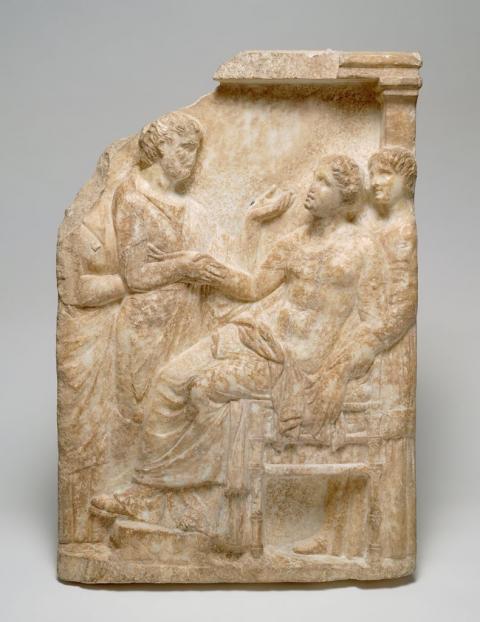richlin
June 29, 2022
With weary hearts, we consider with you what Classics can do in the face of Dobbs v. Jackson Women’s Health Organization, the Supreme Court decision overruling Roe v. Wade (1973) and Planned Parenthood of Pennsylvania v. Casey (1992). We bring you what we can from our own experience: Amy Richlin spent the 1990s teaching half in Gender Studies in the aftermath of the Reagan-Bush administration, when Planned Parenthood v. Casey was heard, and also taught Roman women’s history and sometimes Roman law during her years at USC and UCLA. Bruce Frier has been on the Faculty of the Michigan Law School since 1986 and has participated in numerous discussions and debates concerning Constitutional interpretation; he also chaired a Provostal Committee to improve the campus climate for LGBTQ+ faculty, students, and staff.
Whether you personally are rejoicing or shattered, you know your students will be affected by this decision in ways they probably cannot anticipate. They may well wish to discuss these effects with you, in class or in your office. This summer might be a good time to pick up some basic grounding in the issue of abortion in the United States. We recommend in particular Ellen Messer and Kathryn E. May’s Back Rooms: Voices from the Illegal Abortion Era (1988; now out of print but probably soon back in print); and Kristin Luker’s Abortion and the Politics of Motherhood (1985), which lays out, in a fashion again timely, both pro-choice and pro-life views. For the development of American law, fundamental is Geoffrey R. Stone’s Sex and the Constitution: Sex, Religion, and Law from America’s Origins to the Twenty-First Century (2017). Other resources are in our short list of reading recommendations at the end of this post.
Roe v. Wade was based on the first section of the Fourteenth Amendment (1868), which, amplifying the human objective of “life, liberty, and the pursuit of happiness” in the Declaration of Independence, provides that: “No State … shall … deprive any person of life, liberty, or property, without due process of law.” Almost from the Amendment’s adoption, courts have sought to interpret these vague words. In particular, under the rubric of “substantive due process,” they have isolated what they consider to be certain fundamental aspects of “liberty” that are aggressively protected from State action because they are considered essential to individual freedom, and accordingly they have granted Constitutional protection to this personal freedom. Until last Friday, a woman’s right to seek an abortion had been, with some restrictions, among these personal rights for almost half a century, more than two generations.
However, the majority opinion in Dobbs, written by Justice Samuel Alito, rejects the idea that such “liberty” could include women’s control over their own reproduction, a rejection he bases on the historical question of whether the right recognized in Roe and Casey existed “in 1868, the year when the Fourteenth Amendment was ratified” (dissent, p. 13 of the Slip Opinion). Alito presents an extensive list of US anti-abortion statutes both prior to and subsequent to ratification. We agree with the dissent that the historical argument is disingenuous — “convenient for the majority, but it is window dressing” (p. 14) — so that it is a problem that “the lone rationale ... is that the right to elect an abortion is not ‘deeply rooted in history’” (p. 5, quoting the majority at p. 16 and passim).
If that is the majority’s rationale, then the majority’s assertion that the decision in Dobbs has no consequence for additional rights (such as the right to contraception, or to the private conduct of consensual sex, or to same-gender marriage, all of which are similarly justified through substantive due process) is fallacious, and perhaps deliberately so. As the dissent goes on to say:
One of two things must be true. Either the majority does not really believe in its own reasoning. Or if it does, all rights that have no history stretching back to the mid-19th century are insecure. Either the mass of the majority’s opinion is hypocrisy, or additional constitutional rights are under threat. It is one or the other.
Of Alito’s list of statutes, the dissent remarks that “it is not clear what relevance such early history should have, even to the majority” (p. 13, citing the majority’s own argument in New York State Rifle).
Roe seems to us most plainly grounded in the Declaration of Independence, with the Fourteenth Amendment clarifying the sense of “men,” “liberty,” and “pursuit of happiness” as part of the ending of slavery in the US. In 1868, of course, women still lacked the right to vote; limits on women’s legal personhood were still in play well into the 1960s (dissent, p. 15). The dissent’s reference to “the long sweep of our history” (p. 18) — repudiated by the majority (p. 36) — seems to us to describe plainly the expansion of rights in the second half of the twentieth century and on into the early twenty-first. By contrast, as the dissent states: “Because laws in 1868 deprived women of any control over their bodies, the majority approves States doing so today.”
As classicists, we are in a position to appreciate how very long the expansion of women’s rights has taken and what setbacks it has run into along the way. In agreement with the dissent, we would not hold up “early history” as a model or see it as relevant to the decision in Dobbs. Nonetheless, it is worth at least a brief review of that history. As to Roman law, its position is summarized by Olivia Robinson (The Criminal Law of Ancient Rome, p. 44):
[L]ove potions and fertility drugs were, like abortifacients, considered dangerous, and if their use brought about a death, however inadvertently, such use was made punishable under a resolution of the Senate. Abortion was seen primarily as a particular form of poisoning, performed by the pregnant woman either to thwart her husband or to conceal from him the result of adultery.
As Robinson suggests, the main policy concerns were not with the potential life of the unborn (who in Roman law were not legal persons before their birth), but rather with preventing death of patients through even inadvertent poisoning, and safeguarding the interests of husbands in their wives’ sexual fidelity; the latter policy consideration obviously dropped away outside of marriage. (See also Jane Gardner, Women in Roman Law and Society, pp. 158–159.)
Nevertheless, the everyday practice of contraception and abortion and the use of techniques for increasing fertility are very well attested in Pliny’s Natural History and in the works of numerous medical writers. This was a concern held in common by women of all classes, by midwives, and by doctors (including female doctors). It is generally the case that, the more professional the doctors, the more contemptuous they are of women’s lore, which nevertheless they acknowledge and so attest to. Unsurprisingly, doctors cost money; poor women did without them.
Presumably because of this popular ambivalence, induced abortion was apparently not criminalized until the Severan period in the early third century CE. Some legal sources, such as Ulpian (33 ad Ed.), Digest 48.8.8 (“If it is proved that a woman has brought force to bear on her own innards in order to avoid giving birth, the provincial governor should send her into exile”), might seem to imply that all abortions were now illegal; but, as legal historians have recognized, this fragment originally concerned just married women, the subject of Ulpian’s book 33. The late Classical legal position on abortion then persisted to the time of Justinian and beyond, notwithstanding passionate Christian resistance to the practice after the “quickening” of the fetus (a position inherited from Aristotle).
The abstractions of Roman law should not dissuade us, however, from thinking about the likely reality for Roman women of various classes, especially as concerns accessibility to abortion. The “undue burden” test for State limitations on abortion, to which Casey had appealed, was also dismissed by the majority in Dobbs (p. 6). This principle of constitutional law had been repeatedly invoked to address the differential impact of making abortions harder to get, especially as to increased travel distance. That health care of all kinds is much less available to poor women is a well-known fact, but the dissent provides statistics anyway, most outstandingly from Mississippi (where the Jim Crow effect that followed the Fourteenth Amendment is obviously in play). The fall of Roe has already vastly expanded the number of women who will have to travel far as well as the distance they will have to go. Unlike ancient women, we find ourselves in a situation where reliable and safe health care exists; as in antiquity, however, access to professional health care is limited. Today, in the case of abortion, prohibitions are unequal depending on each state.
As the dissent points out (pp. 47–55), Alito’s fixation on 1868 allowed him essentially to ignore the predictable social consequences of the Dobbs decision. But those consequences may well be severe. For instance, Tacitus (Annales 3.28.3–4) had already observed the dire outcome when a government relies on vigilantes to put law into effect, in the way that Texas SB 8 now does; and such an outcome is sure to be considerably graver in an era when personal information, such as a history of one’s online searches, is so readily accessible to law enforcement and hackers. (This and other intrusive and abusive consequences, including, for instance, weakening the position of women in the workplace, are described by Jia Tolentino.) History teaches us how much more can go wrong.
The American Historical Association filed an amicus brief in Dobbs, so our colleagues in modern history are ahead of us. If your department does not currently offer courses on ancient women or ancient sexuality, we think that now would be a useful time to start. We strongly recommend that all such courses should include a basic introduction to gender-related law and medicine, and to that end we offer primary-source teaching materials developed by Amy Richlin. We also recommend the following books, in addition to readings cited and linked to above:
- Fiona McHardy and Nancy Sorkin Rabinowitz, edd., From Abortion to Pederasty: Addressing Difficult Topics in the Classics Classroom
- Rebecca Flemming, Medicine and the Making of Roman Women: Gender, Nature, and Authority from Celsus to Galen
- Mary R. Lefkowitz and Maureen B. Fant, Women's Life in Greece and Rome: A Source Book in Translation — this widely-used sourcebook includes important sections on Greek and Roman medicine and philosophy; Aristotle’s theories on reproduction were adopted by Thomas Aquinas, thus reaching modernity through the Catholic church
- Enzo Nardi, Procurato Aborto nel Mondo Greco Romano
Header image: Attic Grave Stele: Woman Dying in Childbirth, c. 330 BCE. Image courtesy of Harvard Art Museums.
.png)
Bruce Frier is the John and Teresa D'Arms Distinguished University Professor of Classics and Roman Law, Emeritus, at the University of Michigan.
Authors


